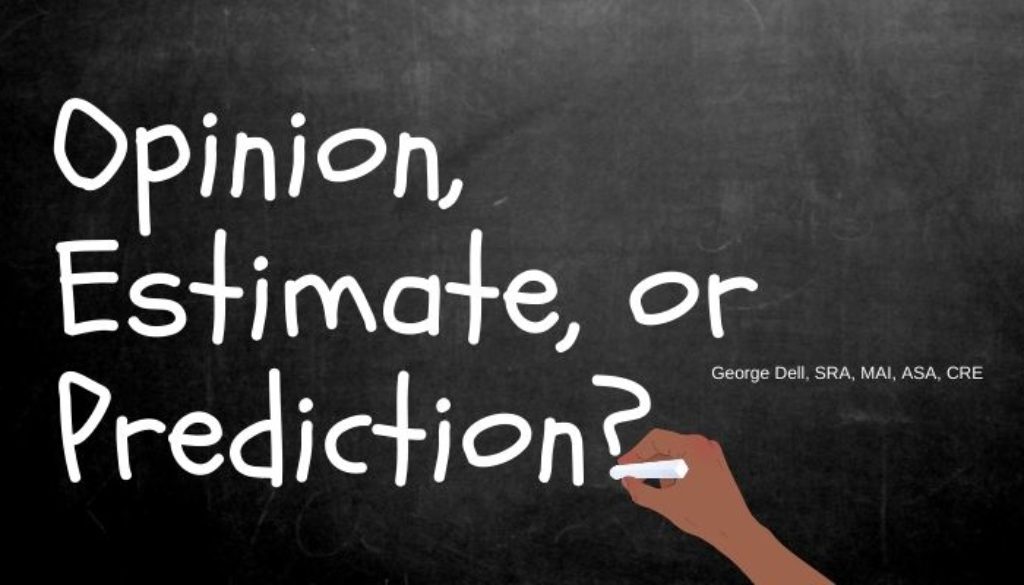Once upon a time, appraisers did not give an opinion! They provided estimates. Why the change?
It seemed appraisers were getting sued over their estimates of value, which opened the door to attack on how the analysis was done. An estimate comes from an analysis.
The professional response: “We will just deliver an opinion!” Safe! No one can attack an opinion. “It is my opinion, and I stand by it.” (All the reviewer can say is “my opinion of your opinion is . . .”)
Let’s see difference between an estimate, an opinion, and predictive analytics:
- An estimate is “an approximate calculation or judgment of a value.”
- An opinion is “a formal expression of judgment or advice by an expert.”
- A prediction is to “foretell on the basis of observation, experience, or scientific reason.”
When I became an appraiser, I was told that “Professional appraisals are more than opinions.” The Appraisal of Real Estate (7th ed., p.2, The Appraisal Institute) states: “Valuation is the act or process of estimating the market value . . .”
By later changing the above thought to “opinion”, the profession was better able to reduce some of the legal responsibility which comes from the “act or process” part of the deal. Clever.
This core reference also states: “a scientific method is applied throughout the appraisal process . . .” Certainly, the appraisal process adapted well to the limited and difficult data sources of the time.
There may (or may not) have been something noted by those more scientifically astute: this renaming of the result of an appraisal breached a critical part of critical science. And the critical part is that the theory must be testable (able to be falsified).
In other words, we hear the result must be able to be tested or shown to be wrong. So here is the rub:
- An opinion cannot be announced to be wrong. It cannot be tested!
- An estimate (or prediction or result) however, can be tested.
Inadvertently, the evolution of the valuation profession may have gone the wrong direction. Leaving behind the testable, falsifiable estimate and moving to a subjective, conclusive “this is my opinion.”
It moved the appraisal profession further away from what is needed and possible.
- The market for valuations (what is needed) has progressed beyond a “point-value opinion two weeks ago.” Today’s need for collateral, investment, and equity decisions requires a basic reckoning of risk and reliability of the result (estimate or prediction).
- The technology of valuation (what is possible) today extends beyond the simplistic, naïve, and barren “trust me” point value. The technology enables:
- At a minimum, a confidence/prediction interval based on professional judgment;
- And possibly, a “certainty coefficient©” based on internal algorithmic assessment.
Lenders, investors, and equity enforcers are moving to digital solutions. The public trust requires it. I commend the FHFA (Federal Finance and Financial Agency) in its pursuit of financial optimization of risk considerations, as well as current issues of citizen housing.
Today’s technology mandates its use. At Valuemetrics.info, our mission is to connect appraisers’ special expertise with the potential of today’s data science tools. A partnership of regulatory commissions, financial markets, modernized education, and new AVM/appraiser standards – can make a difference.

May 24, 2024 @ 5:57 pm
First, many appraisers would add a fourth category – a normative judgment of what a property SHOULD sell for. There is no basis in appraisal definitions or theory for this idea, but if you read appraiser blogs and comments, you will see numerous opinions that “the market is too high,” “the market is overheated,” etc. There are data analysis firms that release reports that purport to show which markets are “overpriced” or correctly priced. But there is no basis in appraisal practice for that kind of statement. And maybe there should be; but clients haven’t asked for it, at least not from appraisers.
Second, if an appraisal is an estimate or prediction of something, what is it estimating or predicting? Market value, you will say – a hypothetical set of circumstances of perfect information, “normal” motivations (whatever that means), in a “fair” sale. Do these conditions occur in the real world? If not, how can the prediction be falsified? Let’s say a property is the only lot on a block that is otherwise owned by one owner. It goes to contract for 50% higher than unassembled properties. What is its market value for appraisal purposes? Will your “prediction” be the contract price, or the “normal” price? If it’s the high price, you will have correctly predicted the sale price, but was it market value? How would you know?
And third, a fundamental of science is that a measurement should be both valid and reliable. That is, it should measure what it purports to measure, and the measurement should be consistent among different measurements and measurers. As for the first, appraisers can’t seem to agree on what is being measured. As for the reliability, this is the most shocking aspect of the purported racial bias cases: that two appraisals, using similar forms and processes as supervised by the entire regulatory structure for 30+ years, can be so far apart in their conclusions.
May 25, 2024 @ 4:45 pm
Thank you for the well-thought out comments.
We have played with the concept of “fundamental” value, which uses other product and service price levels (including rents). Yes, we see a lot of “real value” comparisons, with no real demand for such a product.
Also appreciate your contrast between personal value (to the assembler), verses what ‘typical’ buyers would pay for that parcel.
And yes, we are effectively forced to provide a “most probable” sale price — which may not exist, given the game theory which applies, (as opposed to equilibrium assumptions and results).